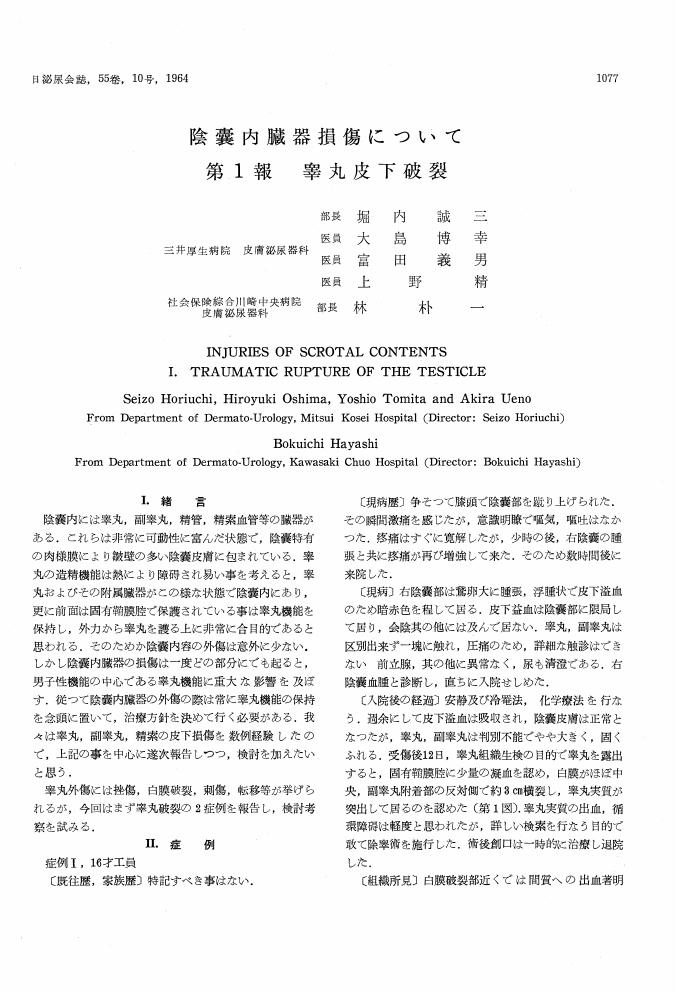1 0 0 0 OA 陰嚢内臓器損傷について 第1報 睾丸皮下破裂
- 著者
- 堀内 誠三 大島 博幸 富田 義男 上野 精 林 朴一
- 出版者
- 社団法人 日本泌尿器科学会
- 雑誌
- 日本泌尿器科學會雑誌 (ISSN:00215287)
- 巻号頁・発行日
- vol.55, no.10, pp.1077-1085, 1964-10-20 (Released:2010-07-23)
- 参考文献数
- 59
1 0 0 0 OA 真性半陰陽の細胞遺伝学的検索
- 著者
- 大島 博幸 酒井 邦彦 高木 健太郎 池上 茂
- 出版者
- 社団法人 日本泌尿器科学会
- 雑誌
- 日本泌尿器科學會雑誌 (ISSN:00215287)
- 巻号頁・発行日
- vol.65, no.11, pp.732-740, 1974-11-20 (Released:2010-07-23)
- 参考文献数
- 44
Eleven cases of true hermaphrodites were investigated with special reference to the relationship between differentiation of gonads and development of sexual duct systems. On most of them were performed studies of the sex chromatin, fluorescent body and chromosomal analysis. Also, reported cases in Japan as well as in foreign countries were collected and reviewed.Chromosomal analysis on 9 cases revealed chromosomal constitutions of 46, XX in 3 cases, 46, XY in 4 and 46, XX/46, XY in 2.Four cases out of 5 patients with a testis at one side and an ovary at the opposite showed Y-bearing chromosomal constitutions. Most of reported cases with a similar type of gonadal developement as the above mentioned were proved to have Y chromosome in their stem cells.Analysis of chromosomes in myelocytes and lymphocytes from a patient with 46, XX/46, XY revealed an interesting result. Twenty-one myelocytes out of 24 had chromosomal constitution of 46, XY and only 3 had 46, XX, whereas almost all of lymphocytes investigated after culture of peripheral blood had 46, XX constitution. It may be suggested from the above finding that cell populations are different from one tissue to another and may influence the differentiation of the primordial gonad toward a testis or ovary. It was another interesting finding that the fluorescent body was observed in 19% of lymphocytes from the patient mentioned above. The observation indicates the importance of examining Barr body as well as fluorescent body on more than two kinds of tissues, because native cells without cell-culture can be utilized for the examinations.Six true hermaphrodites investigated for both Barr and fluorescent bodies consisted of two of 46, XX, 46, XY and 46, XX/46, XY, respectively. Both bodies were positive in each case with mosaicism 46, XX/ 46, XY, although their frequencies were at lower percentage than normal female or male. On the other hand, only a few Barr or fluorescent bodies were recognized in each case of 46, XY or 46, XX, respectively. It is difficult to decide whether the above results were caused by an unrecognized mosaicism or not.From the observations of true hermaphrodites and XX-males, there has been raised an assumption that a sex-determining factor may locate on one of autosomes to which Y chromosome may affect as a regulating factor. This assumption, however, appears not sufficient to explain the differentiation of the ovarian tissue in the case of 46, XY.Testes in the foetus stimulate the differentiation and development of the Wolflian duct and suppress the Mullerian duct. The former function appears to be controlled by one of androgens secreted from the foetal testis. From the observation of clinical cases and animal experiments, the latter function seems to be closely related to the chromosomal constitution of cells composing the ductal tissue, while this function must be mediated by a chemical messenger produced from the foetal testis.
1 0 0 0 IR 膀胱小細胞癌の1例及び本邦報告例の臨床検討
- 著者
- 岡田 洋平 川上 理 福田 博志 長浜 克志 斉藤 一隆 大塚 幸宏 木原 和徳 森田 隆 大島 博幸 江石 義信 菅野 純
- 出版者
- 泌尿器科紀要刊行会
- 雑誌
- 泌尿器科紀要 (ISSN:00181994)
- 巻号頁・発行日
- vol.43, no.10, pp.739-742, 1997-10
- 被引用文献数
- 2
3ヵ月前に無症候性肉眼的血尿に気づいた50歳男で,膀胱左壁の非乳頭状広基性腫瘍を認め,臨床病期はT3N0M0であった.生検材料の病理診断は小細胞癌であった.最初に行ったシスプラチン-アドリアマイシンの動注術前化学療法は無効であり,根治的膀胱摘除を行った.腫瘍組織は明らかに均質で,管状ないし索状に配列した小細胞より成り,pT3bR1L2V0N0であった.電子顕微鏡上,神経分泌顆粒を持つ小細胞癌と確認された.術後,シスプラチン,エトポシド,及びイホスファミドより成るアジュバント化学療法を4クール行った.術後26ヵ月に腫瘍再発の証拠なしに生存しているA 50-year-old man presented with asymptomatic gross hematuria which he had first noticed 3 months earlier. Clinical examinations revealed a non-papillary, broad-based tumor on the left lateral wall of the urinary bladder with a clinical stage of T3N0M0. The pathological diagnosis of a transurethral biopsy tissue specimen was small cell carcinoma. Neoadjuvant intraarterial infusion chemotherapy using cisplatin and adriamycin was initially administered but proved to be ineffective. Thus, we performed a radical cystectomy. The tumor tissue was apparently homogenous and composed of small cells arranged in sheets and solid patterns, and was staged to be pT3bR1L2V0N0. An electron microscopic study confirmed small cell carcinoma with neurosecretory granules. Postoperatively, 4 courses of adjuvant chemotherapy consisting of cisplatin, etoposide and ifosfamide were administered. The patient is alive without any evidence of tumor recurrence 26 months after the operation.
1 0 0 0 IR Stage D2前立腺癌に対する内分泌化学療法 : 化学療法開始時期からみた有用性の検討
- 著者
- 塚本 哲郎 福井 巖 木原 和徳 後藤 修一 北原 聡史 小林 剛 児島 真一 大島 博幸
- 出版者
- 泌尿器科紀要刊行会
- 雑誌
- 泌尿器科紀要 (ISSN:00181994)
- 巻号頁・発行日
- vol.42, no.5, pp.351-356, 1996-05
シスプラチンを含む全身化学療法を用いて治療したステージD2前立腺癌患者29例を3群に分けた. 1)H群:ホルモン療法が化学療法より4週を越えて先行したもの(9例). 2)C群:化学療法がホルモン療法より4週を越えて先行したもの,又は化学療法単独治療例(9例). 3)HC群:ホルモン療法と化学療法の関始時期の差が4週以内のもの(11例). Kaplan-Meier法による5年生存率は,H群が18%, C群が28%, HC群が78%で,HC群が他の2群に比べ良好であったWe retrospectively analyzed 29 patients with stage D2 prostatic cancer who had been treated with chemotherapy at the urological clinic of Tokyo Medical and Dental University Hospital between 1983 and 1992 to evaluate the efficacy of chemotherapy for advanced prostatic cancer. The patients were divided into three groups according to the starting time of chemotherapy in relation to hormone therapy; 9 patients who received chemotherapy more than four weeks after the initial hormone therapy (group H), 9 patients who received chemotherapy only or in combination with the hormone therapy more than four weeks previously (group C), and 11 patients in whom both therapies were started within four weeks (group HC). Follow-up period ranged from four to 108 months averaging 35. Combination chemotherapy including cisplatin was administered one to 17 times with the median of five. The five-year survival rates estimated by Kaplan-Meier method were 18% in group H, 28% in group C, and 78% in group HC, respectively (HC vs. C: p < 0.05, HC vs. H: p = 0.059). These findings indicate that a combination chemotherapy including cisplatin may improve the prognosis of patients with advanced prostatic cancer when it is started with the initial hormone therapy simultaneously.
